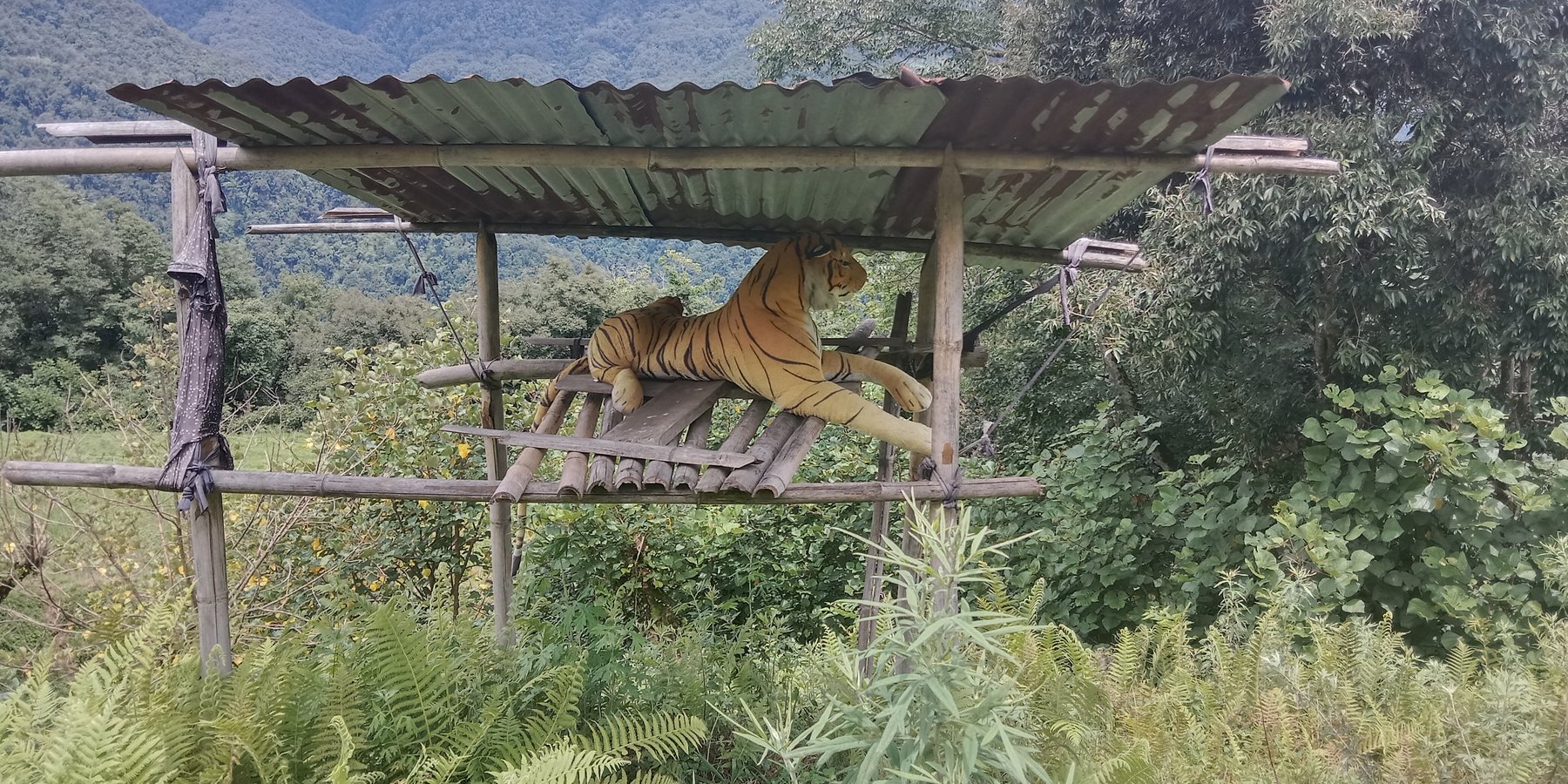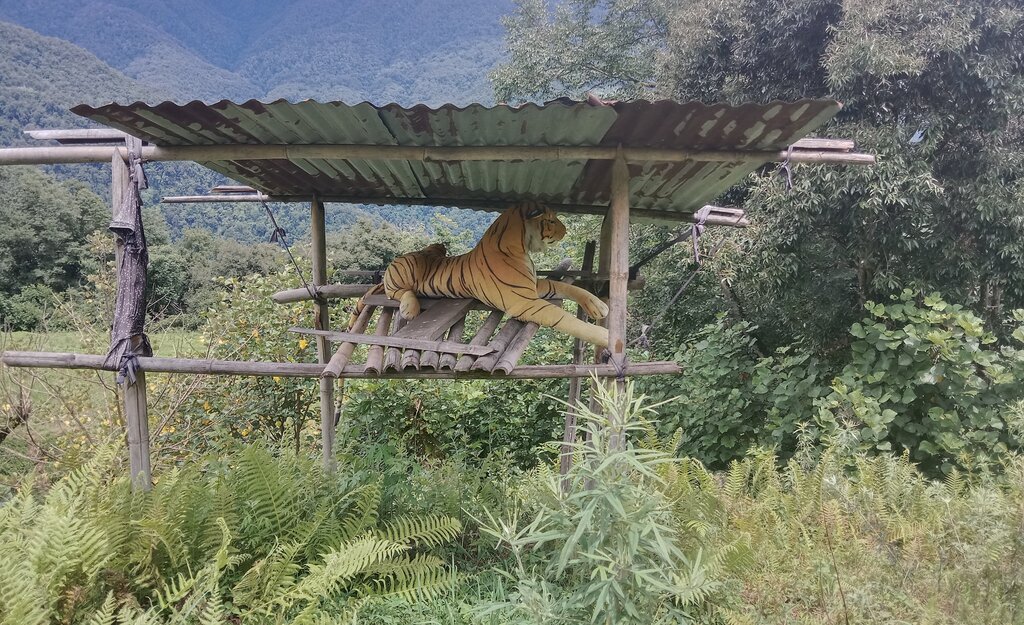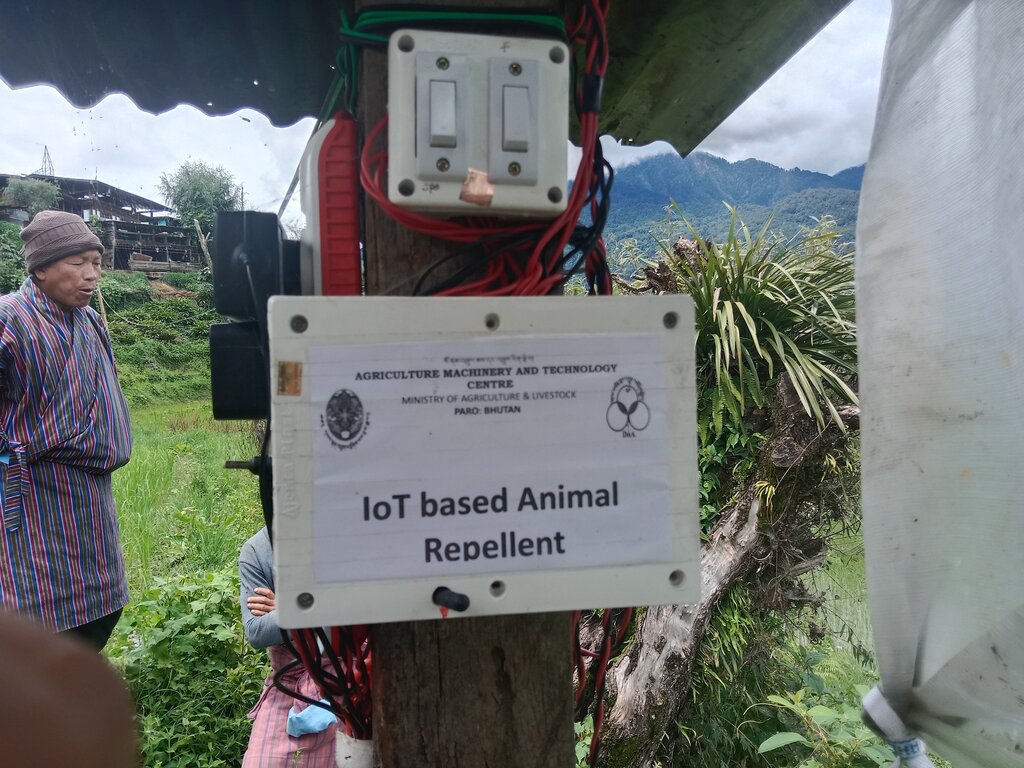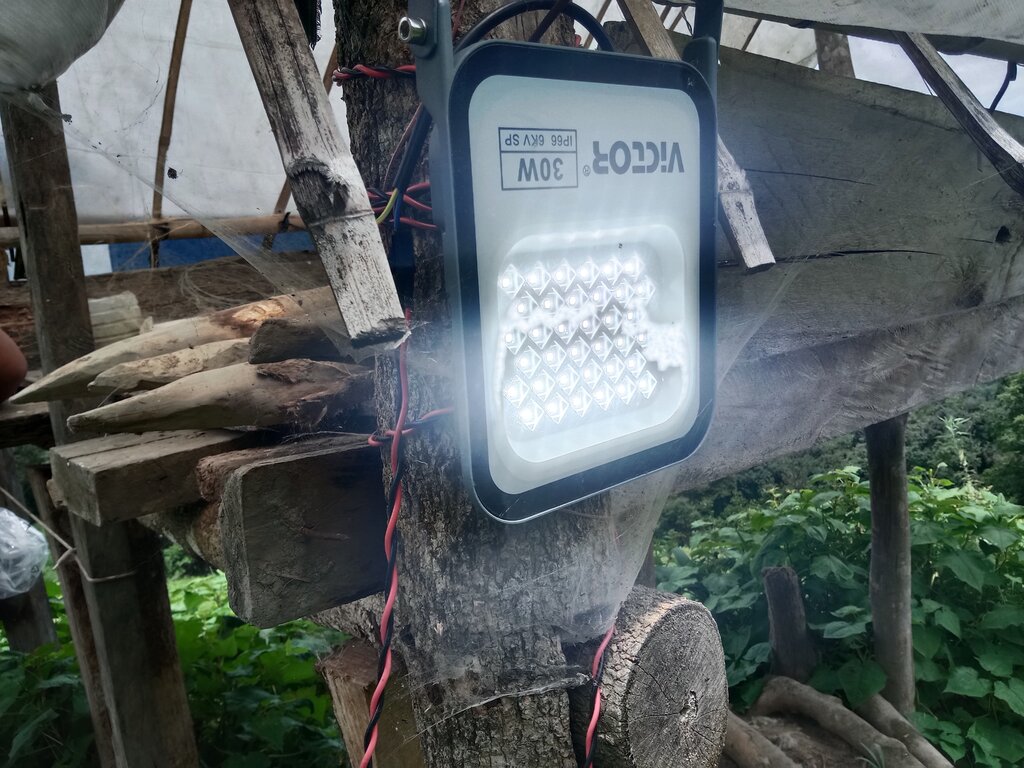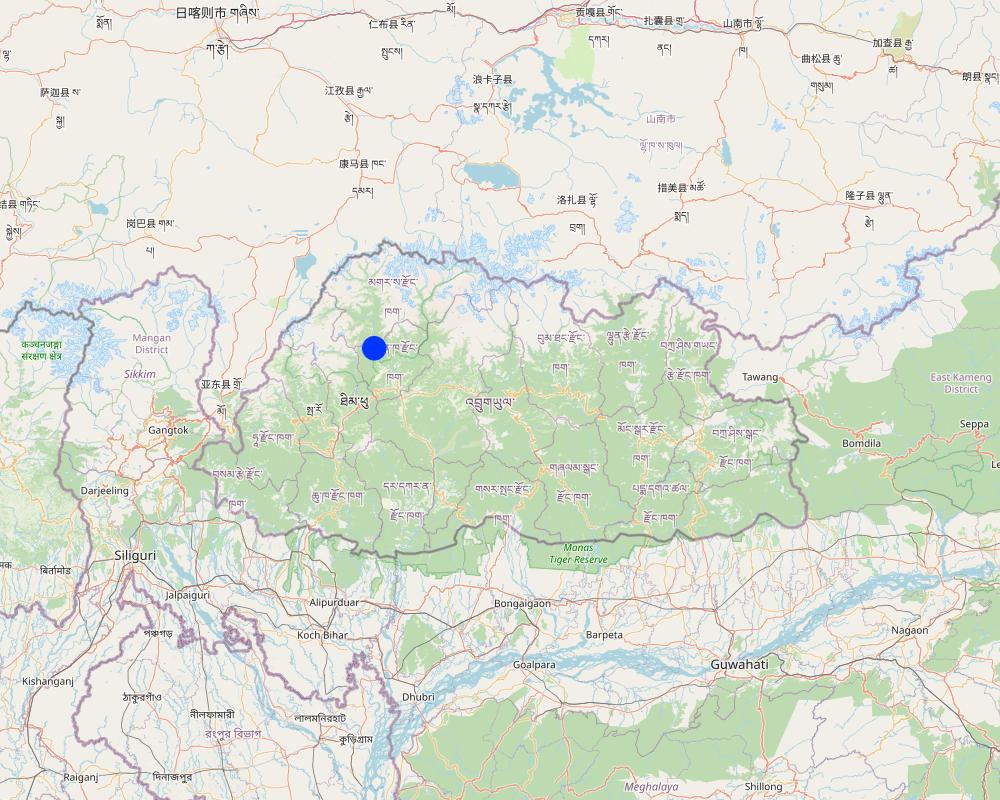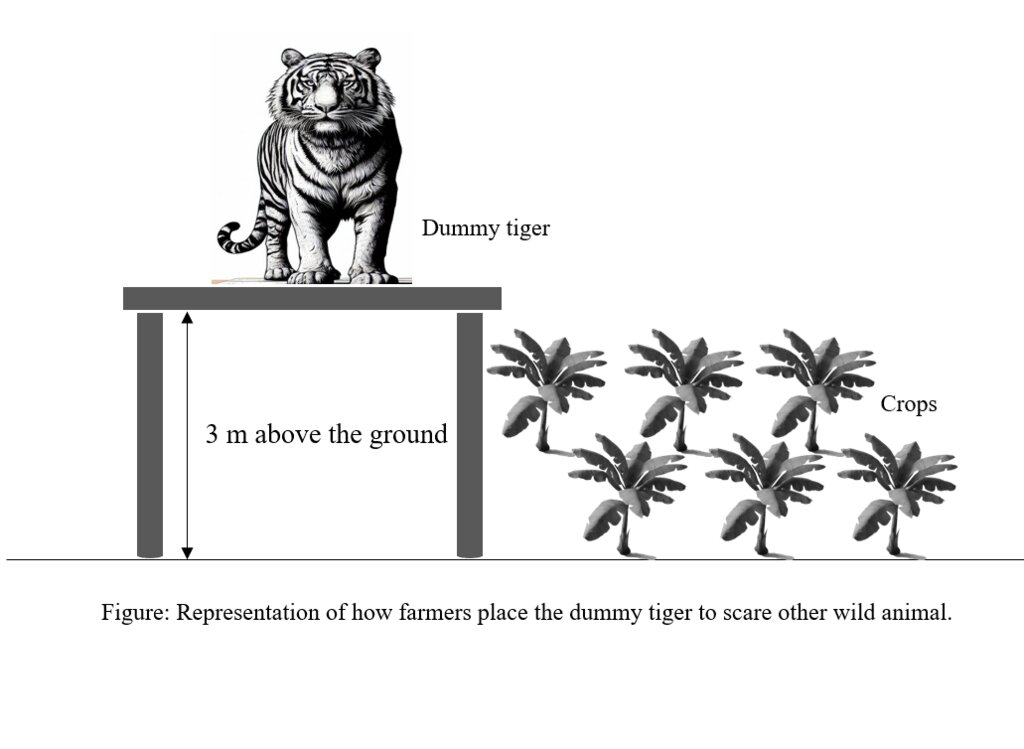Use of Dummy Tigers to Repel Wild Animals [Bhoutan]
- Création :
- Mise à jour :
- Compilateur : Tshering Yangzom
- Rédacteur : chenga Tshering
- Examinateurs : Rima Mekdaschi Studer, William Critchley
Tag Zuenma Laglen Thabtey Lothog Sungchop (སྟག་མཛུན་མ་ལག་ལེན་འཐབ་སྟེ་ལོ་ཐོག་སྲུང་།)
technologies_6860 - Bhoutan
Voir les sections
Développer tout Réduire tout1. Informations générales
1.2 Coordonnées des personnes-ressources et des institutions impliquées dans l'évaluation et la documentation de la Technologie
Personne(s)-ressource(s) clé(s)
exploitant des terres:
Tshering
Drochukha Chiwog (Community), Goenshari Gewog (Block), Punakha Dzongkhag (District)
Bhoutan
exploitant des terres:
Tshering Kinley
Drochukha Chiwog (Community), Goenshari Gewog (Block), Punakha Dzongkhag (District)
Bhoutan
exploitant des terres:
Dorji Kinzang
Drochukha Chiwog (Community), Goenshari Gewog (Block), Punakha Dzongkhag (District)
Bhoutan
exploitant des terres:
Tenzin Namgay
Drochukha Chiwog (Community), Goenshari Gewog (Block), Punakha Dzongkhag (District)
Bhoutan
exploitant des terres:
Kinzang
Drochukha Chiwog (Community), Goenshari Gewog (Block), Punakha Dzongkhag (District)
Bhoutan
exploitant des terres:
Tshering Gyeltshen
Drochukha Chiwog (Community), Goenshari Gewog (Block), Punakha Dzongkhag (District)
Bhoutan
exploitant des terres:
Lhamo Dorji
Drochukha Chiwog (Community), Goenshari Gewog (Block), Punakha Dzongkhag (District)
Bhoutan
Spécialiste GDT:
Gyeltshen Tshewang
Gewog Agriculture Office, Goenshari Gewog (Block), Punakha Dzongkhag (District)
Bhoutan
Nom du projet qui a facilité la documentation/ l'évaluation de la Technologie (si pertinent)
Strengthening national-level institutional and professional capacities of country Parties towards enhanced UNCCD monitoring and reporting – GEF 7 EA Umbrella II (GEF 7 UNCCD Enabling Activities_Umbrella II)Nom du ou des institutions qui ont facilité la documentation/ l'évaluation de la Technologie (si pertinent)
National Soil Services Center, Department of Agric (National Soil Services Center, Department of Agric) - Bhoutan1.3 Conditions relatives à l'utilisation par WOCAT des données documentées
Le compilateur et la(les) personne(s) ressource(s) acceptent les conditions relatives à l'utilisation par WOCAT des données documentées:
Oui
1.4 Déclaration sur la durabilité de la Technologie décrite
Est-ce que la Technologie décrite ici pose problème par rapport à la dégradation des terres, de telle sorte qu'elle ne peut pas être déclarée comme étant une technologie de gestion durable des terres?
Non
Commentaires:
As per the responses, the use of a dummy tiger in guarding crops do not seem to have having direct role in mitigating land degradation. However, it can be claimed as a part of SLM technologies because it protects the crops from wild animals. Standing crops in the field is important to prevent erosion (both soil and water), add nitrogen to the soil (e.g., by leguminous crops), and for nutrient cycling. Also, the use of toy tiger prevents the land user from resorting to fatal methods of crop guarding that necessitates the killing of wildlife.
2. Description de la Technologie de GDT
2.1 Courte description de la Technologie
Définition de la Technologie:
Dummy tigers are used to scare off crop predators. This can be considered a SLM technology because it protects the crops from wild animals which in turn prevents erosion (both soil and water), adds nitrogen to the soil (i.e., by leguminous crops), and helps in nutrient cycling. Furthermore, time is freed up for the farmer to carry out other SLM activities.
2.2 Description détaillée de la Technologie
Description:
In the region of Drochukha, Bhutan, the foremost challenge faced by rural communities is crops damage by wildlife. Land users in this area contend with damage inflicted by a variety of wild animals, including wild boar, barking deer, sambar deer, monkeys, porcupines, bears, and rats. To mitigate crop damage by wildlife, the land users of Drochukha have implemented a unique solution by strategically placing dummy tigers to deter these animals and safeguard their crops.
In 2018, a woman from Drochukha initiated the idea of using dummy tigers to protect crops, and it proved to be highly successful. Following this, other residents also adopted the practice. Farmlands situated near the forest's periphery experience the most significant crop damage by wild animals. By placing dummy tigers near the forest's edge, the land users have not only reduced wildlife attacks in the peripheral regions but also significantly decreased such incidents in the central areas. To protect their crops from wild animals, they procured a dummy tiger at a cost of Nu. 3,380 (about USD 40) from Bajo town in Wangduephodrang Dzongkhag and another dummy tiger costing Nu. 2,000 (about USD 25) from the Indian market in Jaigaon. The land users constructed a raised wooden platform by placing four wooden poles in the ground and adding planks over them to support the dummy tigers, ensuring that they faced the forest.
The implementation of dummy tigers (two) has yielded numerous benefits for 21 households in the region. With the adoption of this innovative approach, Drochukha farmers have been able to increase their crop production and rejuvenate previously unused lands. Dummy tigers effectively safeguard standing crops and prevent wildlife depredation. Maintaining standing crops in the fields is essential to prevent erosion, both of soil and water, while also contributing nitrogen to the soil through the cultivation of leguminous crops and facilitating nutrient cycling. An important aspect of employing dummy tigers is that it prevents land users from resorting to fatal methods of crop protection that may involve the killing of wildlife. Human-wildlife conflicts have thus been reduced. The primary current concern of the land users of Drochukha is the fading colour of the dummy tigers, and they are eager for improved interventions that may involve mobile and sound-producing tigers.
The Agriculture Machinery Centre (AMC) and the Dzongkhag Agriculture Office (DAO) have joined forces to create an IoT-based animal-repellent system. This system, positioned at the field's periphery, comprises three primary components: a speaker, a receptor card, and an amplifier. Once connected to an owner's smartphone, the system allows for the remote playback of various animal sounds. One system, consisting of a single receptor card, can be linked to up to five users. Additionally, two LED flashlights are integrated into the system to deter wild boars at night through powerful pulse flashes. The complete system comes at a cost of Nu. 30,000. Moreover, in their most recent endeavors, AMC and DAO are currently developing a robotic tiger capable of moving its head and limbs, enabling it to patrol the guardhouse and serve as a further deterrent to wildlife. The technology is being piloted as a project to evaluate its effectiveness in the field through trials.
2.3 Photos de la Technologie
Remarques générales concernant les photos:
The IoT-based animal-repellent system is one of the promising technologies that evolved with the need to guard the field in the absence of humans.
2.5 Pays/ région/ lieux où la Technologie a été appliquée et qui sont couverts par cette évaluation
Pays:
Bhoutan
Région/ Etat/ Province:
Drochukha Chiwog, Goenshari Gewog, Punakha Dzongkhag
Spécifiez la diffusion de la Technologie:
- appliquée en des points spécifiques ou concentrée sur une petite surface
Est-ce que les sites dans lesquels la Technologie est appliquée sont situés dans des zones protégées en permanence?
Oui
Si oui, veuillez préciser:
The area falls under Jigme Dorji National Park (JDNP). The park is one of the oldest protected areas in Bhutan. Endowed with a high number of endangered plants and animals supported by a huge range of vegetation types and climatic regimes, JDNP is undoubtedly the conservation jewel in the Eastern Himalayas. It is also the treasure trove of medicinal plants, natural hot springs, medicinal waters, and jaw-dropping sceneries, unparalleled in the country.
Map
×2.6 Date de mise en œuvre de la Technologie
Indiquez l'année de mise en œuvre:
2018
2.7 Introduction de la Technologie
Spécifiez comment la Technologie a été introduite: :
- grâce à l'innovation d'exploitants des terres
Commentaires (type de projet, etc.) :
A lady named Dorji Lhamo of the community, originally from Mongar (Eastern Bhutan) has seen some tiger toys placed at the field peripheries to scare away the wild animals while making her visit to her native village. With much curiosity, she tried doing the same thing in Drochukha (Western Bhutan) where she currently lives. It worked, especially in scaring monkeys away.
3. Classification de la Technologie de GDT
3.1 Principal(aux) objectif(s) de la Technologie
- améliorer la production
- préserver l'écosystème
- créer un impact économique positif
- créer un impact social positif
3.2 Type(s) actuel(s) d'utilisation des terres, là où la Technologie est appliquée
Les divers types d'utilisation des terres au sein du même unité de terrain: :
Oui
Précisez l'utilisation mixte des terres (cultures/ pâturages/ arbres):
- Agroforesterie

Terres cultivées
- Cultures annuelles
- Cultures pérennes (non ligneuses)
- Plantations d’arbres ou de buissons
Cultures annuelles - Précisez les cultures:
- céréales - orge
- céréales - maïs
- céréales - riz (de terres humides)
- céréales - blé d'hiver
Cultures pérennes (non ligneuses) - Précisez les cultures:
- bananier/plantain/abaca
- herbs, chili, capsicum
Plantations d'arbres et d'arbustes - Précisez les cultures:
- avocat
- citron
Nombre de période de croissance par an: :
- 1
Est-ce que les cultures intercalaires sont pratiquées?
Oui
Si oui, précisez quelles cultures sont produites en culture intercalaire:
Vegetables are intercropped.
Est-ce que la rotation des cultures est appliquée?
Oui
Si oui, veuillez préciser:
Vegetables are rotated.

Forêts/ bois
- Forêts (semi-)naturelles/ bois
Forêts (semi-)naturelles/ terres boisées: précisez le mode de gestion:
- Coupes sélectives
- Utilisation de la forêt non liée au bois
Est-ce que les espèces d’arbres précisées ci-dessus sont des espèces d'arbre arbres à feuilles caduques ou à feuilles persistantes ?
- forêt mixte décidue/ à feuillage persistant
Produits et services:
- Bois d'œuvre (de construction)
- Bois de chauffage
- Autres produits forestiers
3.3 Est-ce que l’utilisation des terres a changé en raison de la mise en œuvre de la Technologie ?
Est-ce que l’utilisation des terres a changé en raison de la mise en œuvre de la Technologie ?
- Non (Passez à la question 3.4)
3.4 Approvisionnement en eau
Approvisionnement en eau des terres sur lesquelles est appliquée la Technologie:
- mixte: pluvial-irrigué
Commentaires:
The community has two irrigation sources, Khaow Lum benefiting 6 households, and Jaga Lum benefiting all 21 households.
3.5 Groupe de GDT auquel appartient la Technologie
- Human-wildlife conflict management
3.6 Mesures de GDT constituant la Technologie

structures physiques
- S11: Autres
Commentaires:
This SLM technology would fall under the structure category as it requires a simple structural wooden stand to place the tiger toys.
3.7 Principaux types de dégradation des terres traités par la Technologie

érosion hydrique des sols
- Wt: perte de la couche superficielle des sols (couche arable)/ érosion de surface

érosion éolienne des sols
- Et: perte de la couche superficielle des sols (couche arable)

dégradation biologique
- Bc: réduction de la couverture végétale
Commentaires:
Based on the responses, it appears that the utilization of toy tiger decoys for crop protection may not be directly associated with mitigating land degradation. Nevertheless, it can be considered a component of Sustainable Land Management (SLM) technologies since it serves to safeguard crops from wildlife damage. Preserving standing crops in fields holds significance in preventing erosion, both in terms of soil and water. Furthermore, standing crops contribute to soil enrichment by introducing nitrogen (e.g., through leguminous crops) and facilitate nutrient cycling. Another crucial aspect is that the toy tigers effectively deter wildlife from preying on crops, and they also aid in repelling vertebrate pests from fields.
3.8 Prévention, réduction de la dégradation ou réhabilitation des terres dégradées
Spécifiez l'objectif de la Technologie au regard de la dégradation des terres:
- prévenir la dégradation des terres
- réduire la dégradation des terres
Commentaires:
Based on the responses, it seems that the use of toy tigers may not directly address land degradation. However, it can be categorized as a component of Sustainable Land Management (SLM) technologies because it plays a role in protecting crops from wildlife damage. Maintaining standing crops in fields is essential for erosion prevention, both in terms of soil and water conservation. Additionally, it contributes to soil enrichment by introducing nitrogen, especially through the cultivation of leguminous crops, and supports nutrient cycling. Another significant aspect is that toy tigers effectively serve as a deterrent against wildlife crop depredation and help in repelling vertebrate pests from fields
4. Spécifications techniques, activités, intrants et coûts de mise en œuvre
4.1 Dessin technique de la Technologie
Spécifications techniques (associées au dessin technique):
The tiger toys are placed 3 meters above the ground. To ensure stability, the toys are placed on the planks supported by strong poles.
Auteur:
Ongpo Lepcha
Date:
11/12/2023
4.2 Informations générales sur le calcul des intrants et des coûts
Spécifiez la manière dont les coûts et les intrants ont été calculés:
- par entité de la Technologie
autre/ monnaie nationale (précisez):
Nu.
Indiquez le taux de change des USD en devise locale, le cas échéant (p.ex. 1 USD = 79.9 réal brésilien): 1 USD = :
80,0
Indiquez le coût salarial moyen de la main d'œuvre par jour:
800
4.3 Activités de mise en place/ d'établissement
| Activité | Calendrier des activités (saisonnier) | |
|---|---|---|
| 1. | Procurement of tiger toys. | Before cropping season |
| 2. | Construction of guard houses using any available materials to place the tiger toys. | Before cropping season |
| 3. | Placing the tiger toys. | Cropping season |
Commentaires:
The need for repainting the faded colours and the lack of movement of the tiger toys are the shortcomings associated with this technology.
4.4 Coûts et intrants nécessaires à la mise en place
| Spécifiez les intrants | Unité | Quantité | Coûts par unité | Coût total par intrant | % du coût supporté par les exploitants des terres | |
|---|---|---|---|---|---|---|
| Main d'œuvre | Labor | man/day | 1,0 | 800,0 | 800,0 | 100,0 |
| Autre | Tiger toy | No. | 1,0 | 3380,0 | 3380,0 | 100,0 |
| Autre | Tiger toy | No. | 1,0 | 2000,0 | 2000,0 | 100,0 |
| Coût total de mise en place de la Technologie | 6180,0 | |||||
| Coût total de mise en place de la Technologie en dollars américains (USD) | 77,25 | |||||
Commentaires:
The current costing is being done based on the local market value of tiger toys. As per the respondents, the tiger toy of the required size cost Nu. 3380 from the local market (Wangdi Phodrang), whereas the same tiger cost Nu. 2000 from the Indian (Jaigoan) market.
4.5 Activités d'entretien/ récurrentes
Commentaires:
Since the adoption began in 2018, no maintenance, including the replacement of tiger toys, has been necessary. However, in the upcoming years, maintenance may become necessary due to the fading color of the tiger toys.
4.6 Coûts et intrants nécessaires aux activités d'entretien/ récurrentes (par an)
Si vous n'êtes pas en mesure de décomposer les coûts dans le tableau précédent, donnez une estimation du coût total de l'entretien de la Technologie:
5346,0
Commentaires:
Buying two new dummy tigers as replacements would cost approximately 66 USD (Nu. 5346) on the higher pricing end and around 50 USD (Nu. 4050) on the lower pricing end.
5. Environnement naturel et humain
5.1 Climat
Précipitations annuelles
- < 250 mm
- 251-500 mm
- 501-750 mm
- 751-1000 mm
- 1001-1500 mm
- 1501-2000 mm
- 2001-3000 mm
- 3001-4000 mm
- > 4000 mm
Zone agro-climatique
- semi-aride
Dry sub tropical
5.2 Topographie
Pentes moyennes:
- plat (0-2 %)
- faible (3-5%)
- modéré (6-10%)
- onduleux (11-15%)
- vallonné (16-30%)
- raide (31-60%)
- très raide (>60%)
Reliefs:
- plateaux/ plaines
- crêtes
- flancs/ pentes de montagne
- flancs/ pentes de colline
- piémonts/ glacis (bas de pente)
- fonds de vallée/bas-fonds
Zones altitudinales:
- 0-100 m
- 101-500 m
- 501-1000 m
- 1001-1500 m
- 1501-2000 m
- 2001-2500 m
- 2501-3000 m
- 3001-4000 m
- > 4000 m
Indiquez si la Technologie est spécifiquement appliquée dans des:
- non pertinent
5.3 Sols
Profondeur moyenne du sol:
- très superficiel (0-20 cm)
- superficiel (21-50 cm)
- modérément profond (51-80 cm)
- profond (81-120 cm)
- très profond (>120 cm)
Texture du sol (de la couche arable):
- grossier/ léger (sablonneux)
- moyen (limoneux)
Texture du sol (> 20 cm sous la surface):
- grossier/ léger (sablonneux)
- moyen (limoneux)
Matière organique de la couche arable:
- abondant (>3%)
Si disponible, joignez une description complète du sol ou précisez les informations disponibles, par ex., type de sol, pH/ acidité du sol, capacité d'échange cationique, azote, salinité, etc.
Moisture content-3.10%
Organic matter-7.08 %
Organic carbon-4.12%
pH-6.35
Electrical conductivity-181.33 µs/cm
Nitrogen-0.21
Phosphorus-0.21
Potassium-81.90 mg/100ml
Soil texture-Loamy sand
5.4 Disponibilité et qualité de l'eau
Profondeur estimée de l’eau dans le sol:
5-50 m
Disponibilité de l’eau de surface:
bonne
Qualité de l’eau (non traitée):
eau potable
La qualité de l'eau fait référence à:
eaux de surface
La salinité de l'eau est-elle un problème? :
Non
La zone est-elle inondée?
Non
Commentaires et précisions supplémentaires sur la qualité et la quantité d'eau:
A landslide in the community was recorded in 1991, losing about one acre of land.
5.5 Biodiversité
Diversité des espèces:
- élevé
Diversité des habitats:
- élevé
Commentaires et précisions supplémentaires sur la biodiversité:
The greater vegetation coverage at the outskirts of the community indicates a higher level of habitat and species biodiversity.
5.6 Caractéristiques des exploitants des terres appliquant la Technologie
Sédentaire ou nomade:
- Sédentaire
Orientation du système de production:
- exploitation mixte (de subsistance/ commerciale)
Revenus hors exploitation:
- 10-50% de tous les revenus
Niveau relatif de richesse:
- moyen
Individus ou groupes:
- individu/ ménage
Niveau de mécanisation:
- travail manuel
- mécanisé/ motorisé
Genre:
- femmes
- hommes
Age des exploitants des terres:
- jeunes
- personnes d'âge moyen
Indiquez toute autre caractéristique pertinente des exploitants des terres:
The Drochukha community came into existence after their ancestors migrated to the current site from Gasa Dzongkhag some 50 years ago. Only 2 of 21 households are native.
5.7 Superficie moyenne des terres utilisées par les exploitants des terres appliquant la Technologie
- < 0,5 ha
- 0,5-1 ha
- 1-2 ha
- 2-5 ha
- 5-15 ha
- 15-50 ha
- 50-100 ha
- 100-500 ha
- 500-1 000 ha
- 1 000-10 000 ha
- > 10 000 ha
Cette superficie est-elle considérée comme de petite, moyenne ou grande dimension (en se référant au contexte local)?
- moyenne dimension
Commentaires:
The land holdings of the household in the community range from 1 - 5 acres, a mix of small-scale and large-scale as per the local context. The average land holding at the national level is 3 acres (1.2 ha)
In the local context:
3 acres (1.2 ha) = medium scale
> 3 acres = large-scale
<3 acres = small-scale
5.8 Propriété foncière, droits d’utilisation des terres et de l'eau
- Family land
Droits d’utilisation des terres:
- individuel
Droits d’utilisation de l’eau:
- communautaire (organisé)
- individuel
Est-ce que les droits d'utilisation des terres sont fondés sur un système juridique traditionnel?
Oui
Précisez:
The land use rights in Bhutan is based on a traditional legal system guided by formal land act and land rules and regulations.
5.9 Accès aux services et aux infrastructures
santé:
- pauvre
- modéré
- bonne
éducation:
- pauvre
- modéré
- bonne
assistance technique:
- pauvre
- modéré
- bonne
emploi (par ex. hors exploitation):
- pauvre
- modéré
- bonne
marchés:
- pauvre
- modéré
- bonne
énergie:
- pauvre
- modéré
- bonne
routes et transports:
- pauvre
- modéré
- bonne
eau potable et assainissement:
- pauvre
- modéré
- bonne
services financiers:
- pauvre
- modéré
- bonne
6. Impacts et conclusions
6.1 Impacts sur site que la Technologie a montrés
Impacts socio-économiques
Production
production agricole
Quantité avant la GDT:
125kg
Quantité après la GDT:
250kg
Commentaires/ spécifiez:
Previously, farmers could only harvest approximately 125 kg of potatoes when planting 250 kg of seeds. Now, they can harvest nearly 1500 kg of potatoes from the same amount of seeds.
Revenus et coûts
dépenses pour les intrants agricoles
Commentaires/ spécifiez:
Daytime crop guarding against monkeys is no longer necessary, allowing land users to allocate their time to other productive activities.
revenus agricoles
Commentaires/ spécifiez:
With no need for daytime crop guarding, land users can engage in off-farm activities, earning up to Nu. 800 per day. This has proven to be advantageous in increasing their overall farm income.
diversité des sources de revenus
Commentaires/ spécifiez:
Off-farm earning has become possible. Production and marketing of other seasonal crops and high-value crops are possible.
charge de travail
Commentaires/ spécifiez:
The continuous daytime guarding is not required anymore.
Impacts socioculturels
sécurité alimentaire/ autosuffisance
Commentaires/ spécifiez:
The land users can produce enough for self-consumption and commercialization.
opportunités culturelles
Commentaires/ spécifiez:
The use of lethal methods for crop protection is no longer necessary, thus preventing the killing of wild animals
Impacts écologiques
Biodiversité: végétale, animale
contrôle des animaux nuisibles/ maladies
Commentaires/ spécifiez:
The control of vertebrate pests, especially monkeys, has been very successful.
6.2 Impacts hors site que la Technologie a montrés
Protection of farms further from the land users' farms
Commentaires/ spécifiez:
Toy tigers protect farms further from the land users' farms also. There is no intrusion of wild animals into the villages.
6.3 Exposition et sensibilité de la Technologie aux changements progressifs et aux évènements extrêmes/catastrophes liés au climat (telles que perçues par les exploitants des terres)
Changements climatiques progressifs
Changements climatiques progressifs
| Saison | Augmentation ou diminution | Comment la Technologie fait-elle face à cela? | |
|---|---|---|---|
| températures annuelles | augmente | très bien | |
| précipitations annuelles | augmente | très bien |
Extrêmes climatiques (catastrophes)
Catastrophes météorologiques
| Comment la Technologie fait-elle face à cela? | |
|---|---|
| pluie torrentielle locale | très bien |
| orage local | très bien |
| averse de grêle locale | très bien |
| tempête de vent locale | très bien |
Catastrophes climatiques
| Comment la Technologie fait-elle face à cela? | |
|---|---|
| conditions hivernales extrêmes | très bien |
Catastrophes biologiques
| Comment la Technologie fait-elle face à cela? | |
|---|---|
| maladies épidémiques | très bien |
| infestation par des insectes/ vers | très bien |
6.4 Analyse coûts-bénéfices
Quels sont les bénéfices comparativement aux coûts de mise en place (du point de vue des exploitants des terres)?
Rentabilité à court terme:
très positive
Rentabilité à long terme:
très positive
Quels sont les bénéfices comparativement aux coûts d'entretien récurrents (du point de vue des exploitants des terres)?
Rentabilité à court terme:
très positive
Rentabilité à long terme:
très positive
Commentaires:
The technology is cost effective and every individual can afford it easily.
6.5 Adoption de la Technologie
- 11-50%
Si disponible, quantifiez (nombre de ménages et/ou superficie couverte):
Out of the 21 households, 10 have embraced the technology. The reason for this is primarily that the remaining 11 households have their lands situated in the central part of the community and do not share boundaries with the forests.
De tous ceux qui ont adopté la Technologie, combien d'entre eux l'ont fait spontanément, à savoir sans recevoir aucune incitation matérielle, ou aucune rémunération? :
- 91-100%
Commentaires:
The expenditures were borne by the farmers. No external funding was involved in buying tiger toys.
6.6 Adaptation
La Technologie a-t-elle été récemment modifiée pour s'adapter à l'évolution des conditions?
Oui
autre (précisez):
Modern technology integration
Spécifiez l'adaptation de la Technologie (conception, matériaux/ espèces, etc.):
The Agriculture Machinery Centre (AMC) and the Dzongkhag Agriculture Office (DAO) have joined forces to create an IoT-based animal-repellent system. This system, positioned at the field's periphery, comprises three primary components: a speaker, a receptor card, and an amplifier. Once connected to a owner's smartphone, the system allows for the remote playback of various animal sounds. One system, consisting of a single receptor card, can be linked to up to five users. Additionally, two LED flashlights are integrated into the system to deter wild boars at night through powerful pulse flashes. The complete system comes at a cost of Nu. 30,000.
Moreover, in their most recent endeavors, AMC and DAO are currently developing a robotic tiger capable of moving its head and limbs, enabling it to patrol the guardhouse and serve as a further deterrent to wildlife. The technology is being piloted as a project to evaluate its effectiveness in the field through trials.
6.7 Points forts/ avantages/ possibilités de la Technologie
| Points forts/ avantages/ possibilités du point de vue de l'exploitant des terres |
|---|
| The crop production is enhanced. |
| Lethal methods for crop protection have been avoided. |
| Overall farm income is increased after the adoption of technology. |
| Points forts/ avantages/ possibilités du point de vue du compilateur ou d'une autre personne ressource clé |
|---|
| No major threats to the external environment and user friendly technology. |
| Tiger toy protects the crops from wild animals. Standing crops in the field is important to prevent erosion (both soil and water), add nitrogen to the soil (e.g., by leguminous crops), and for nutrient cycling. The other important aspect is toy tiger prevents wildlife depredation. |
6.8 Faiblesses/ inconvénients/ risques de la Technologie et moyens de les surmonter
| Faiblesses/ inconvénients/ risques du point de vue de l’exploitant des terres | Comment peuvent-ils être surmontés? |
|---|---|
| The colour fading of tiger toys could be a problem in the future. | Repaint toy tigers. |
| Financial burden on the land users. | Implement a cost-sharing mechanism. |
| Faiblesses/ inconvénients/ risques du point de vue du compilateur ou d'une autre personne ressource clé | Comment peuvent-ils être surmontés? |
|---|---|
| The wild animals especially the monkeys might get used to tiger toys. | A robotic tiger producing sounds in certain intervals would be the next best innovation, which is already under process. |
7. Références et liens
7.1 Méthodes/ sources d'information
- visites de terrain, enquêtes sur le terrain
7
- interviews/entretiens avec les exploitants des terres
7
- interviews/ entretiens avec les spécialistes/ experts de GDT
1
Quand les données ont-elles été compilées (sur le terrain)?
18/07/2023
7.3 Liens vers les informations pertinentes en ligne
Titre/ description:
Introduction – Jigme Dorji National Park
URL:
https://www.dofps.gov.bt/introduction-jigme-dorji-national-park/
Liens et modules
Développer tout Réduire toutLiens
Aucun lien
Modules
Aucun module trouvé


